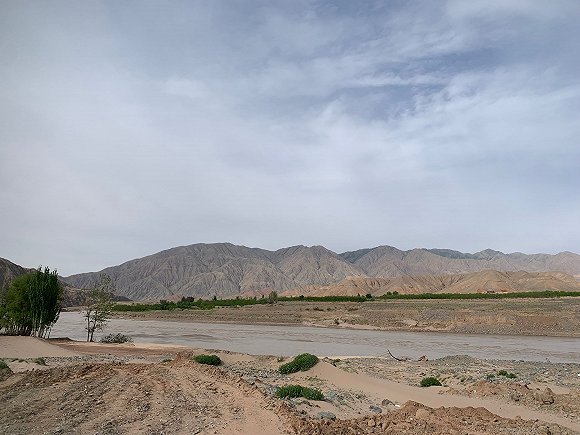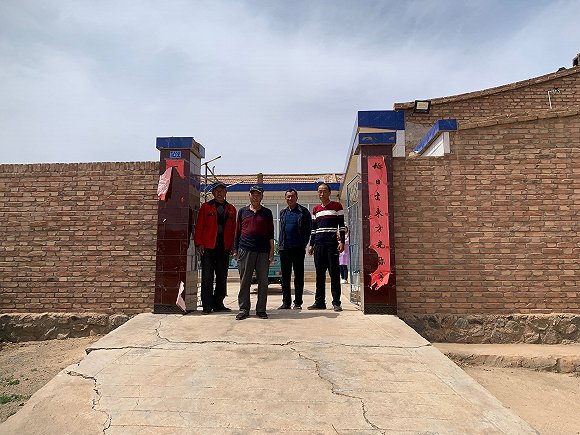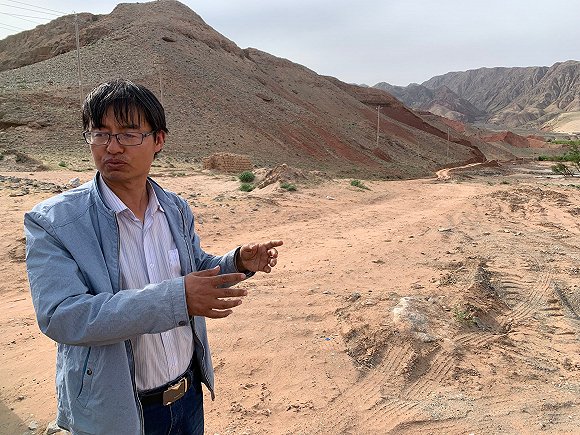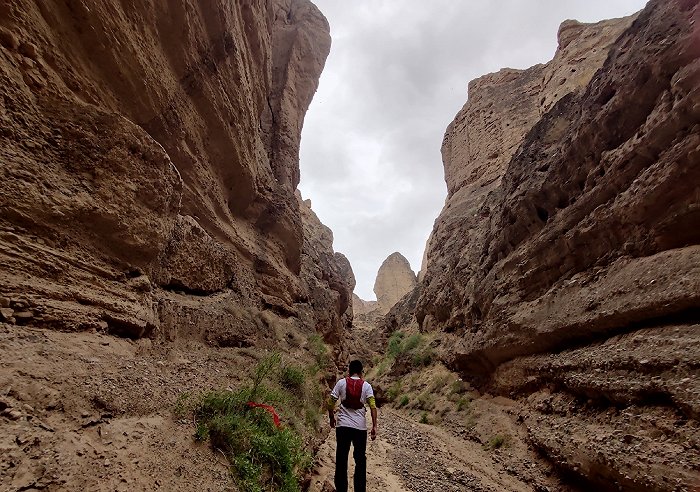A storm descended. An ultramarathon turned into a disaster. Shepherds and villagers raced against time to save as many runners as they could find.

On May 22, a group of runners passing by a steep mountain trail in Jingtai, Gansu Province.
By ZHAI Xingli, DING Qianqian
On May 22, an ultramarathon in China’s northwestern province of Gansu turned into a disaster. A storm descended on a mountain range about a third into the race. 172 inadequately clothed and ill-equipped runners were caught in strong winds and pelted by rain and hail. Hypothermia set in. 21 runners died. 8 were hospitalized.
The first SOS message was sent at 12:17pm. When rescuers were dispatched from nearby towns, their vehicles stumbled upon a vast impassable terrain of boulders, cliffs, and rough riverbeds. It took another nine hours for them to get past them. During this time, local shepherds and villagers mobilized, racing against time and risking their own lives to save as many runners as they could find.
It is impossible to verify who sent out the first SOS message. The WeChat group of the ultramarathon was disbanded the day after the tragedy.

SHANG Lishan, a 39-year-old shepherd, found the first runner hours after setting out from Changsheng, a small mountain village near the area. The man was lying motionless not far from the race trail, eyes open, all vitals gone. He might have collapsed after getting lost in a heavy fog. Shang and his fellow rescuers carried him to a cave and then kept looking for others. That night, they found two more runners, both dead.
Shang was home when the first SOS text popped up in the shepherd’s own WeChat group around noon. “Take warm clothes you have and go to the mountains,” a shepherd said. “Something is wrong.”
At first, there was no way to verify the accuracy of the message. He felt uneasy — strong wind and heavy rain were forecast, and that was why he stayed home. After two hours of asking around in vain, he jumped into his car and headed towards the mountains. He reached the end of the paved road, and Shang had to leave his car by the Yellow River and set out on foot to Checkpoint 3, where many runners were said to be.
Shang later learned that he was among the first to arrive at the scene, deep inside an endless stretch of wildland, rarely visited other than by shepherds. At 8pm that night, he finally met with firefighters dispatched from a nearby town, and the group traced the trail in the dark, praying the surviving runners had not wandered off too far.
“We were too late,” Shang said. The group carried the bodies of the dead runners to a cave that shepherds use for shelter. Not far away from there, another shepherd, ZHU Keming, had better luck. He happened to be in the mountains when the storm descended and was able to escort six shivering runners to safety.
The 100-kilometer race took place at the Yellow River Stone Forest Park, the organizers had placed nine checkpoints along the way. The area, marked by rough, hilly terrains, is notorious for wild swings in weather.

Zhu Keming told a newspaper that inclement weather was “quite common” in the region, but in another interview later with CCTV, the national broadcaster, he called the extreme weather on the race day “very rare”.
According to an official statement, a storm moved in early in the afternoon of May 22, near a high-altitude area about one-third into the race between Checkpoint 2 and Checkpoint 3. Heavy hail and strong winds raged as the temperature dropped to freezing point. Many runners suffered hypothermia.
Questions have since been raised on whether the race was called off too late. A photographer recalled that the wind was already so strong by midmorning that he wasn’t able to set up his tripod. He informed the race organizers but didn’t hear anything back.
ZHU Jiandong was working in his maize field near Checkpoint 2 when the rain started. He was at first awed by the sight of runners pushing forward on a steep slope in the intensifying rain, but soon grew worried. Temperature drops can be quick and ruthless in the mountains. He and his wife had kept some warm clothes in a shack near the field, and his wife suggested giving them to the runners.
The couple dashed out into the hail and waited by the race trail, urging every runner they met to put on a coat and take shelter in his shack. The villagers knew that no one could survive long in such weather. Not far away from them, two other families were also giving out clothes and ushering runners to shelters.

By this time, villagers, runners, and volunteers were jamming the organizer’s phone line begging to call off the race. At Checkpoint 2, a 69-year-old runner, a famous physician, heard a volunteer yelling into the wind that “the race must stop immediately!” The person on the other side of the phone was unmoved despite the volunteer’s repeated pleading. The race continued.
Zhu Keming, the villager, also rushed into the rain after hearing calls for help. A runner had collapsed and was having a seizure. He helped him into a cave, where he made calls to the race hotline. That afternoon, he found five more runners — one of them was oblivious to the danger and had to be dragged off the trail — and led them to safety. Another two runners had already lost all vitals when he found them.
One of the runners who passed by the cave insisted on finishing the race. Zhu had to run beside her for almost two kilometers before she was convinced there was nothing but danger ahead.
The warnings and SOS messages at first didn’t cause much alarm with the race organizers. When WANG Zhong, the Party secretary of Changsheng village, got a call from the organizers at 2:30pm, he was only told to send warm clothes and comforters to the race area. He set out to collect them, still unaware of the impending disaster. Two hours later, Zhu Keming’s wife called. Two runners had collapsed and “may not make it”, she pleaded, and Zhu Keming himself couldn’t be reached due to spotty reception. Wang sensed the danger and immediately ordered every grown man in the village, 60 of them and mostly aged over 50, to head to the mountains.

They rendezvoused with town firefighters at the Yellow River. With the villagers leading the way, they started searching in small groups. The terrain was too rough for rescue vehicles, so the teams hiked in the dark for more than two hours before they reached the worst-hit area near Checkpoint 3.
When LUO Weihui, a 54-year-old villager arrived at the storm-hit mountain range, two nurses who arrived earlier sprung to their feet and waved desperately. A 60-year-old runner had fallen unconscious, but the nurses were not strong enough to carry him to shelter. The men moved him to a nearby cave and continued to look for others.
Later that night, they found the bodies of three more runners, among them LIANG Jing, an ultramarathon champion and one of the most respected runners in the country. Liang was found in a crop field, knees severely abraded.
The field was not far from Checkpoint 3. The beacon of the checkpoint was a strip of scarlet cloth strapped in the grass and a wooden signboard.

With the sudden temperature drop during the race, heavy fog enveloped the mountain. Luo reckoned Liang got lost in the haze and succumbed to the cold.
Back in the cave, the old runner woke up around midnight and asked for bread. The nurses handed him a small chunk and told him to eat slowly. Shaken and relieved, the man broke into tears.
Shang Lishan, the shepherd, pushed on throughout the night. The twelve-person team, exhausted, took a short break around midnight and shared the last bottle of water. A SWAT team soon arrived, the rescuers regrouped, and Shang continued to lead the way.
They were assigned to search along a deep riverbed, sandwiched between two steep riverbanks. Five victims were found there, four on the bank and one at the bottom. It was unclear how they died. A runner could easily lose her footing and fall to death, but some victims seemed to have crawled for a distance before their strength wore out – a line of bloodstain behind the body proved that. Later that night, Shang found another victim, a woman, at the bottom of a narrow gorge — a less exposed spot. He felt sorry for her, for she might have survived if help had arrived earlier.
The search went on. By the early hours of May 23, only one runner was unaccounted for. The rescuers’ navigation devices were dying, and Shang struggled to tell the exact location on the map from a blurry screenshot last sent by the missing runner. Two groups of rescuers scoured the area until dawn, and the body was finally found in the early morning, 18 hours after the first SOS message was sent.
YANG Kai (not his real name), an experienced rescuer, first learned of the disaster on the afternoon of May 22. The storm had been raging for hours, and a stranded runner, desperate for help, reached him through a mutual friend. He was not in Gansu then, but immediately called the race organizers and offered help. To his aghast, the organizers didn't provide any useful information and later blocked his phone number.
He went to the race anyway. After the rescue, he walked most of the race trail and was surprised at how inadequately prepared it was. The trail was badly marked, making it almost impossible to navigate in rain, hail, or fog. A large swath of the race area couldn’t be reached by vehicles, which delayed the arrival of help. There were no helicopters or even enough GPS receivers to track runners’ locations. The response team was short-handed. Before shepherds, villagers, rangers, and town firefighters arrived, only ten professional rescuers were on standby for emergencies, enough people to search and carry only one injured person over a long distance by standard search and rescue practice.

When help arrived, treatments were not immediately administered to hyperthermic runners, who might have appeared without vitals but still could have been revived by CPR and proper warming. “It might be bad communication. No one told the rescuers that the runners were hyperthermic. Or nonprofessional rescuers simply didn’t know what to do.”
It shouldn’t have been like this, Yang said. The disaster could have been avoided.